#musée du luxembourg
Explore tagged Tumblr posts
Text

01-01-2025
#parijs#paris#walking#flaneur#place saint sulpice#saint sulpice#leeuwen#fontein#met jos#1 januari#musée du Luxembourg#tamara de amaral#brazil#tentoonstelling#exposition#expositie
3 notes
·
View notes
Text
Picasso, en veux-tu, en voilà...
Picasso forever. Or at least, 50 times Picasso, 50 years after his death. I didn't see all 50 (!), I saw only 3. But I loved them all. However often we may have seen some of the works shown, they remain fascinating.
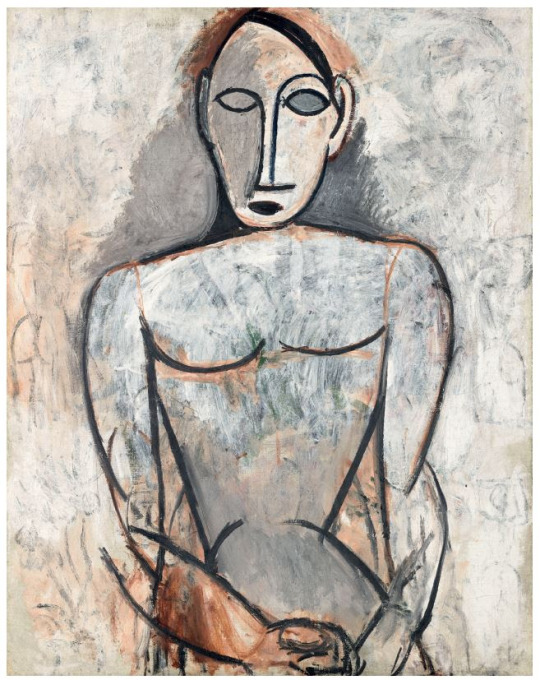
View On WordPress
#art#Célébration-Picasso#Centre Pompidou#exposition#Françoise Gilot#Gertrude Stein#musée du Luxembourg#peinture#Picasso#vaut le détour#Von der Heydt Museum
1 note
·
View note
Text
"Рождество в Америке" (Christmas in America), 1919 г.
Художник Альфонс Муха (Alphonse Mucha, 1860-1939)
Холст, масло. Musée du Luxembourg, Париж.

#“Рождество в Америке” (Christmas in America)#1919 г. Художник Альфонс Муха (Alphonse Mucha#1860-1939)Холст#масло. Musée du Luxembourg
0 notes
Text

GERTRUDE STEIN and PABLO PICASSO The Invention of Language
Pablo Picasso e Geltrude Stein arrivarono a Parigi uno dalla Spagna, l’altra dall’America e gettarono le basi delle avanguardie del XX secolo, in pittura e in letteratura
0 notes
Text
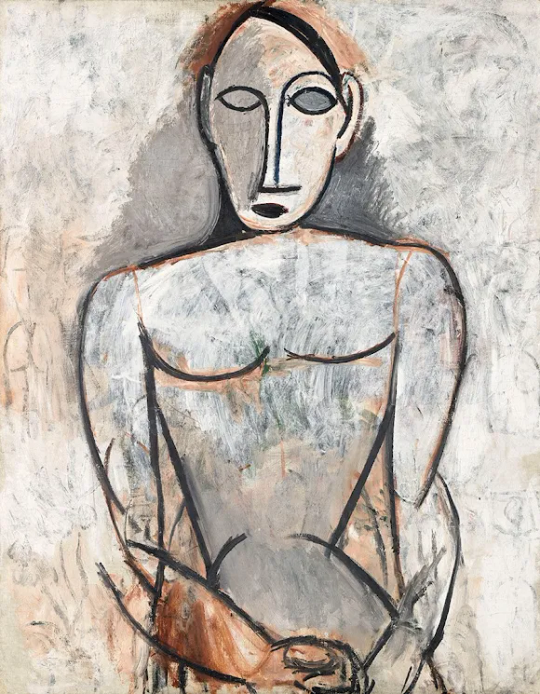
#exposition#selfartnews#galerie#art#paris#GERTRUDE STEIN ET PABLO PICASSO / MUSÉE DU LUXEMBOURG (FR)
1 note
·
View note
Text






« Tarsila do Amaral. Peindre le Brésil »
Musée du Luxembourg, Paris
#art#painting#art history#brazilian art#brazil#latinx artist#latin american art#tarsila do amaral#drawing
256 notes
·
View notes
Text

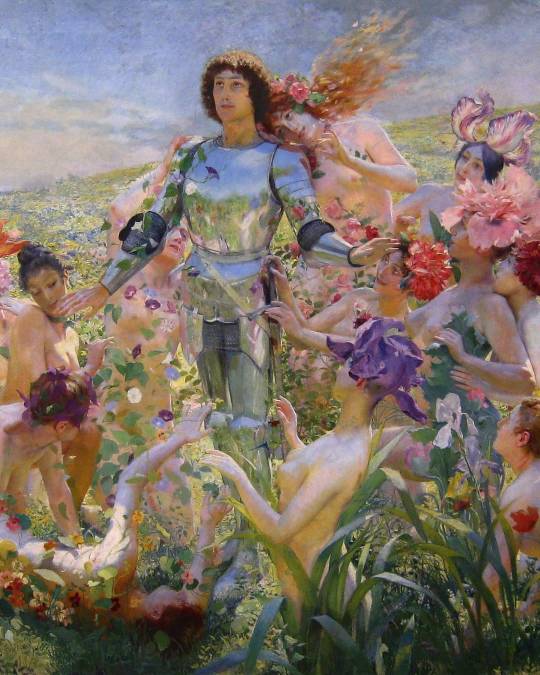

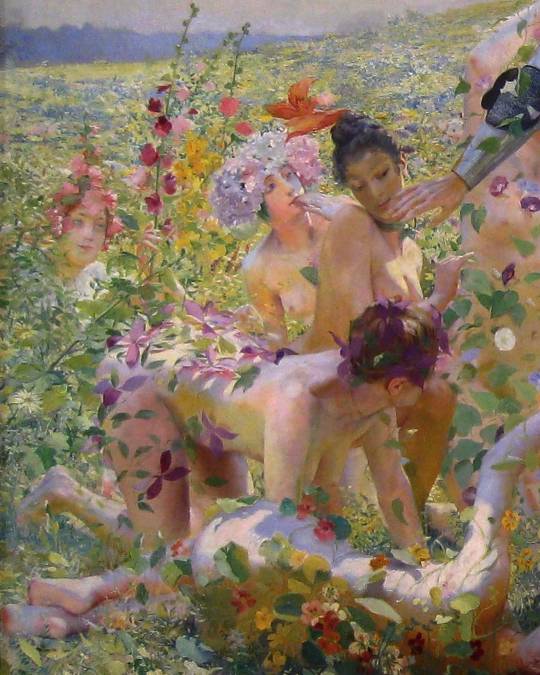

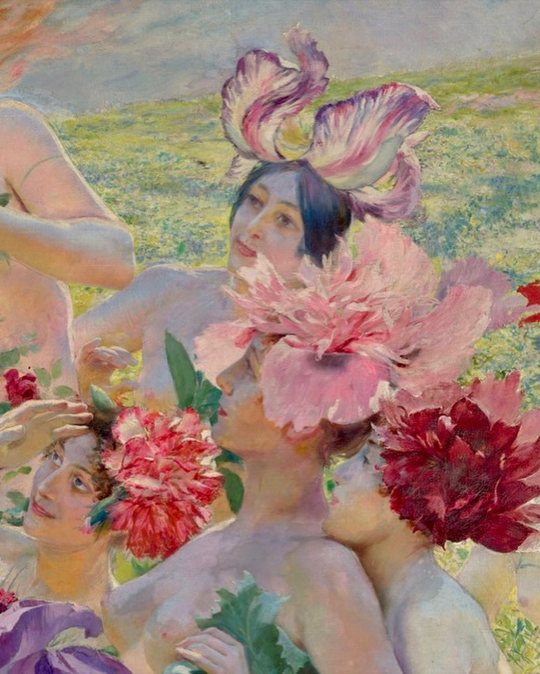
GEORGES ROCHEGROSSE - THE KNIGHT OF THE FLOWERS, 1894
The painting depicts a scene inspired by Richard Wagner's opera "Parsifal." The central figure is Parsifal, an Arthurian knight, who is shown entering the enchanted garden of Klingsor's castle. He is portrayed in full armor, symbolizing his purity and dedication to his quest for the Holy Grail. He stands resolute and unmoved by external distractions, demonstrating his resistance to temptation.
Surrounding Parsifal are the Flower Maidens, or flower nymphs, who are trying to seduce him. These figures are adorned with various flowers like narcissi, peonies, roses, irises, tulips, violets, and hydrangeas. They represent temptation and the worldly pleasures that Parsifal must resist to stay true to his spiritual journey. However, Parsifal remains focused, ignoring the calls and gestures of the maidens.
Rochegrosse introduces several distinctive elements when compared to other interpretations of the character from different artists who might choose to depict Parsifal in scenes of his quest for the Holy Grail, his healing of Amfortas, or his anointment as Grail King. For instance, Franz Stassen's illustrations for Wagner's "Parsifal" often show Parsifal in more spiritual or heroic contexts, like the Grail ceremony or his final act of healing.
Beyond critical reviews, "The Knight of the Flowers" was significant enough to be acquired by the French state for the Musée du Luxembourg, indicating not just official recognition but also a broader public appreciation. This acquisition suggests that the painting resonated with the cultural and artistic tastes of the period, where there was a fascination with decadence, mysticism, and the exploration of human psychology through art.
64 notes
·
View notes
Text
I know I spent two days without posting any lesbian pride post lol but I swear I'm gonna post two posts per day in the following days to make up for it. I am again going to talk about an artist, but from a different period this time.
Rosa Bohneur !
(I love her name by the way... Bohneur means happiness in french and that's such a pretty name to have)

Marie-Rosalie Bonheur, known as Rosa Bonheur, was born in 1822 in Bordeaux and died in 1899 in Thomery. She was a French painter and sculptor specialising in representations of animals.
She has kind of an interesting family story (mother adopted by a rich guy who found out later who was her real father, siblings all artists, father who met a lot of interesting people, links with many famous people...) but it would be too long to talk about it and I want to focus on Rosa herself. Do check it up if you're interested!
During her youth, Rosa Bonheur had a reputation for being a tomboy, a reputation that followed her throughout her life and which she made no attempt to deny, wearing her hair short and later smoking cigarettes and cigars. Her emancipated lifestyle never caused a scandal, even though she lived in an era that was very concerned with convention. Like all women of her time, Rosa Bonheur had to apply to the Prefecture of Paris for a cross-dressing permit, renewable every six months, in order to wear trousers, in particular to attend livestock fairs, travel or ride horses.
Here's one of her permits, from 1857 :

And though many historians tried to deny the fact that she was a lesbian, she always refused to marry a man, has only ever had relationships with women and literally wrote that she never felt any sort of love, attraction or tenderness for men, "besides a frank and good friendship for those who had all my esteem". After the death of the woman she loved, she also wrote "If I'd been a man, I'd have married her, and they wouldn't have made up all those silly stories..." You got it : even if she didn't shout it from the rooftops, Rosa was very probaby a homosexual woman.

Rosa Bohneur grew up in a fairly wealthy family, thanks to the financial support of her mother's adoptive father. But when her mother's father died, the family was left without any such support, and fell into dire poverty. When Rosa was 11, her mother died, which deeply traumatised her. She kept a lifelong admiration for her mother.
In 1836, at the age of 14, she met Nathalie Micas, who became her lover. Only Nathalie's death 53 years later separated them.
Her father remarried in 1842 to Marguerite Peyrol, with whom he had a last son, Germain, who would also become a painter. Rosa Bonheur did not get on well with her stepmother and when her father died in 1849, she left the family home to live with the Micas.
After her mother's death, Rosa Bonheur went to primary schools, was apprenticed as a dressmaker and then went to boarding school. Eventually her father took her into his workshop, where her artistic talents were revealed. He was her one and only teacher. Gradually, she developed a passion for animal art, which became her speciality.
She exhibited for the first time, at the age of 19, at the Salon of 1841. She won a 3rd class medal at the Salon of 1845, and a 1st class medal (gold) at the Salon of 1848. This award enabled her, at the age of 26, to obtain a commission from the State to produce an agrarian painting (paid 3,000 francs). The painting resulting from this state commission, "Labourage nivernais" was supposed to go to the Musée des Beaux-Arts in Lyon. But it was so successful at the 1849 Salon that the Beaux-Arts department decided to keep it in Paris, at the Musée du Luxembourg. After Rosa Bonheur's death, the work went to the Louvre, before being transferred to the Musée d'Orsay in 1986.

When her father died in March 1849, Rosa Bonheur replaced him as director of the École impériale gratuite de dessin pour demoiselles (or École gratuite de dessin pour jeunes filles). She remained in this position until 1860: ‘Follow my advice and I'll turn you into Leonardo da Vinci in skirts’, she often told her pupils.
In 1860, she moved to a huge house in By, where she had a huge workshop built, and ample space for her animals. One of her relatives wrote: “She had a complete menagerie in her house: a lion and a lioness, a deer, a wild sheep, a gazelle, horses, etc. One of her pets was a young lion she let run around. My mind was freer when this leonine animal died".
In June 1864, Rosa was visited by Empress Eugenie, who invited her to lunch at the Château de Fontainebleau with her husband. The following year, Eugenie returned to see her, to present her with the Legion d'honneur herself. Rosa is the ninth woman and the first artist to receive this distinction. About this, The Empress said :
“At last, you've been knighted. I am delighted to be the godmother of the first woman artist to receive this high distinction. I wanted the last act of my regency to be devoted to showing that, in my eyes, genius has no sex."
She was also the first woman to be made an officer in this order, in April 1894 (first female officer of the Legion d'honneur).
Rosa traveled extensively with her lover Nathalie, herself a painter and mechanical enthusiast (she invented and patented a railway braking system), and painted many pictures inspired by her travels.
In 1889, Nathalie died after some 50 years together. It was then that Rosa expressed her regret at not having been able to marry her.
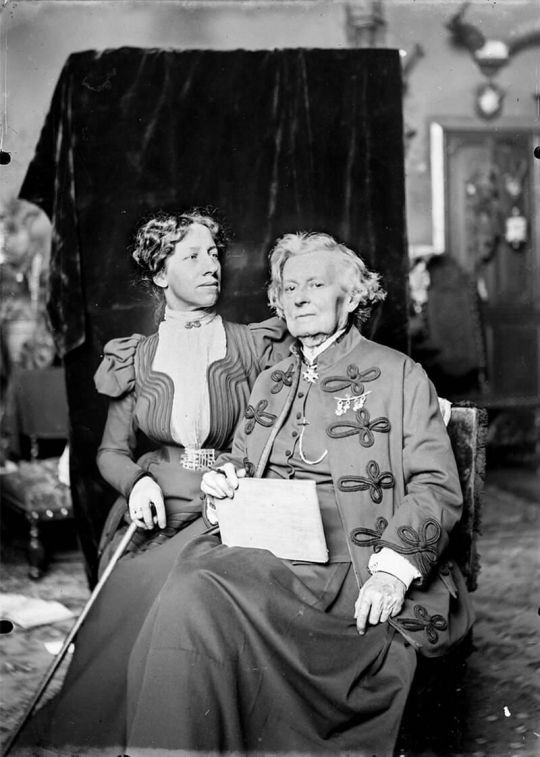
After Nathalie's death, Rosa met Anna Klumpe, a talented American painter. The two women moved in together some time later.
Rosa Bohneur died of pulmonary congestion in 1899, without having completed her last painting, “La foulaison du blé en Camargue”, a monumental canvas she had planned to exhibit at the 1900 Universal Exhibition.
She is buried in Père Lachaise cemetery, alongside Nathalie, her parents and Anna (who died years after her). She left her entire fortune to Anna, who, in 1908, published a biography of Rosa Bonheur and created a Rosa-Bonheur prize at the Société des artistes français. The Société des Artistes français posthumously awarded her the Medal of Honor shortly after her death.
Rosa could have had military honors at her funeral, but she specified in her will that she did not wish this.
There's a lot of interesting things to say about Rosa, her art and her history, so I suggest you do some research on her! She was a very talented and strong-willed woman who had a huge impact on French art and left a considerable cultural legacy.
Here are some of her paintings :
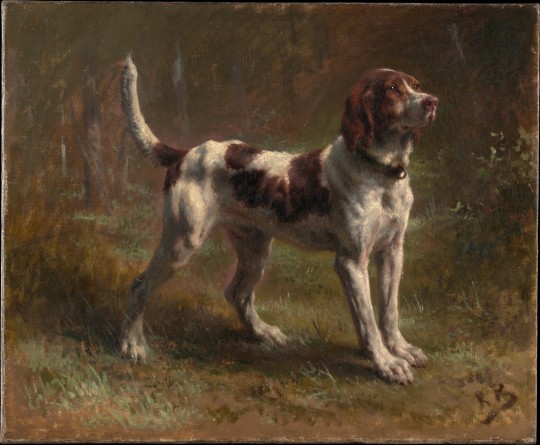
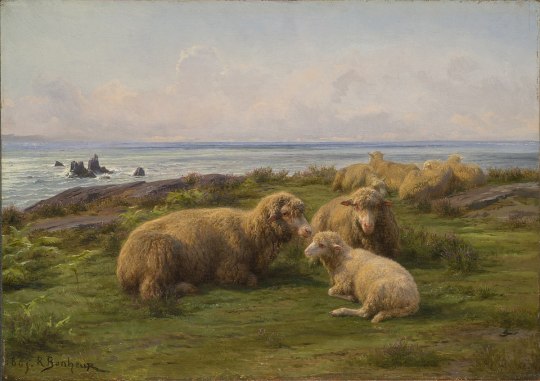

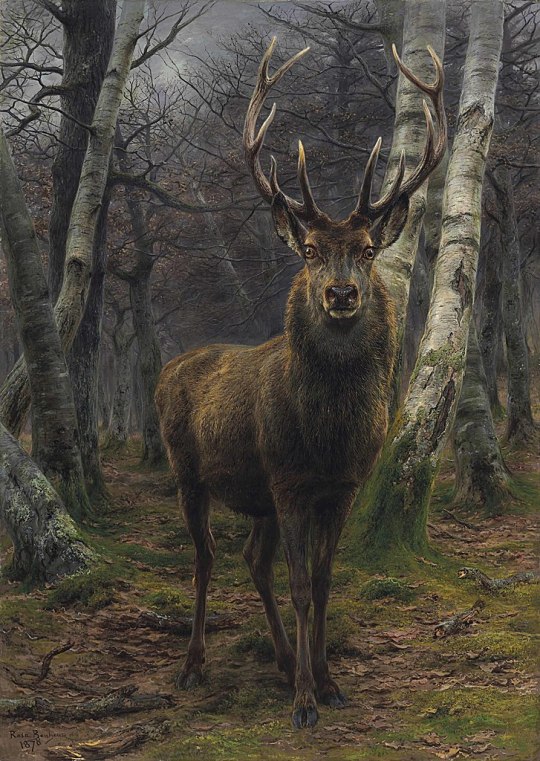
I personally love them ! I am not a painting expert, I just find them sooo pretty.
See you tomorrow :)
#lesbian#lesbian pride#pride#pride month#female homosexual#female homosexuality#rosa bonheur#french art#painting#art#lesbian history
224 notes
·
View notes
Text
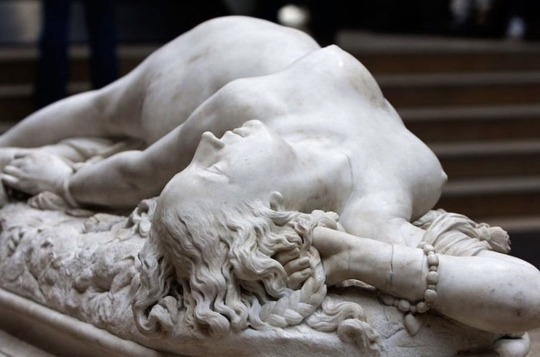

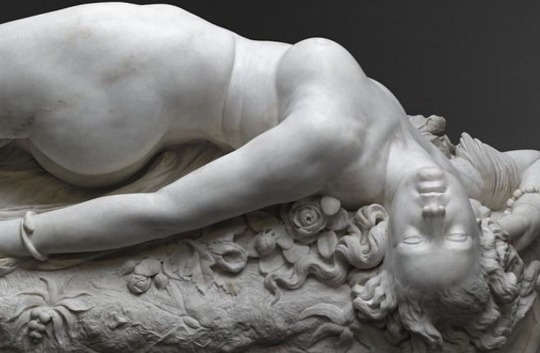
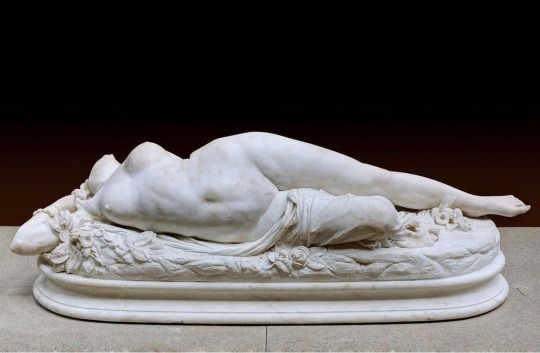

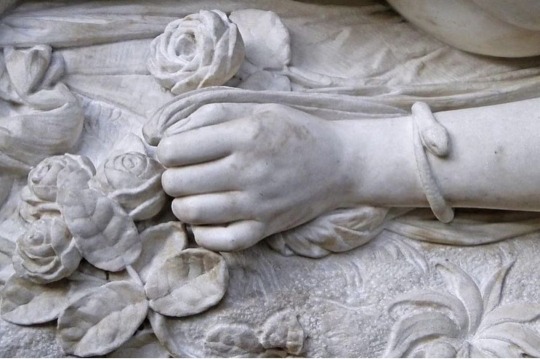

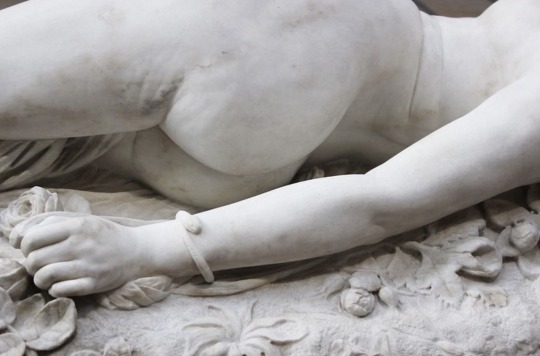
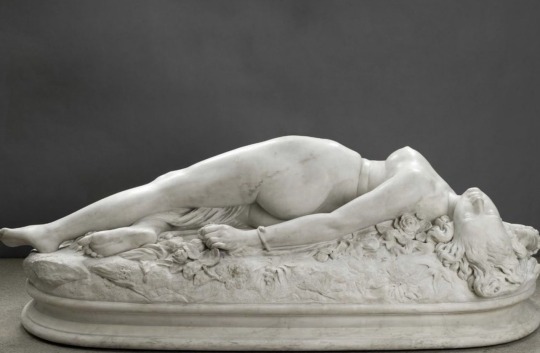

Woman Bitten by a Serpent, by Clésinger…...
This captivating marble carving caused a great scandal in the 1847 Parisian Salon. A suggestive image of a naked woman writhing from the pain of a bite inflicted by the snake twisted around her wrist, or that may be just a cover story for something else? Scandalous like few, critics claimed that this masterpiece was produced from a life cast of the commissioner's mistress, Apollonie Sabatier
- also muse to Baudelaire and known as "La Présidente" - as to claim the artist was lazy, unskilled and immodest, and pointed to the dimpled flesh at the top of her thighs to strengthen their point. Proof that there is no such a thing as bad publicity, Clésinger had his friend Theophile Gauter orchestrate the scandal to grow the sculpture's success.
Auguste Jean-Baptiste Clésinger
(1814-1883) was a painter and sculptor known for the sensuality of his works. Trained by his father, also a celebrated sculptor belonging to the Besancon school of painting, he began exhibiting in the Parisian Salon in 1843 and earned immediate success. He produced plenty of acclaimed busts, such as those of Rachel Félix, Louis of Savoy and his dear friend Theophile Gautier.
His works are displayed in places of the highest distinction such as the Jardin du Luxembourg and the Musee d'Orsay in Paris, and was much admired for the funerary monument of Chopin in the Pere Lachaise Cemetery, where he is buried himself, along with many others. After a failed marriage he met his model and mistress Berthe de Courrière, to whom he was still devoted until the end of his life. He received the Légion d'honneur in 1849.
• Height: 56,5 cm (22.2 in). Width: 180 cm (71 in). Marble, 1847.
fIr Musée d'Orsay, Paris.
#art#beauty#photography#vintage#black and white#60s style#the paradigm web#painting#abstraction#nude figure
331 notes
·
View notes
Text
some of my fav st sebastian statues <3 by Ján Weiss, located in Prešov, Eastern Slovakia

CAN WE TALK ABT THE GOLD DETAILS??? IM GOING CRAZYYYYY LIKE THE HALO BEHIND HIM,,,,,, AMAZING artist unknown, located in Vysehrad, Prague

again. the gold details are BEAUTIFUL BUT HIS EXPRESSION AND POSTURE ARE SOOOO GOOD AS WELL by Pierre Puget, located in Santa Maria Assunta, Genoa, Italy

OK NO THIS WINS FOR BEST POSE HIS LEGS AND THE ANGLE OF HIS HEAD???? need to draw galahad like this by Giuseppe Giorgetti, located in San Sebastiano fuori le mura, Rome

FREE MY MAN WHYS HE IN A BOX,,,,,,,,,, WHYD THEY JAIL HIM?? ti really love the reclining pose tho! he looks much more peaceful here our last sebastian......... by Just Becquet, located in The Musée du Luxembourg

the cloth is AMAZINGGGGGG AND THE POSE WITH HOW HES ELEVATED AAAAAAAAAAA god i wish i could find more pics of it from dif angles,,,,,,,
#i hope yall enjoy the brainrot djsfhiodsj this was fun!!#i love statues sm#next time i go to europe imma be tracking some of these down fr#st sebastian
37 notes
·
View notes
Text
Birthday Bingo Celebration: Paris: Terry Silver x Reader

Tagging: @volumesofforgottenlore@kmc1989@somethingdarkside17@noonee333

You spend your thirtieth birthday alone in Paris, touring all the places you haven’t had an opportunity to visit during your time with the residential program. You trawl through the vintage shops in Le Marais, selecting some of the less expensive pieces. You wander through the Jardin du Luxembourg and finally you visit the Louvre.
It's there that you meet him, the man that changes your life forever. You’re sitting on a bench admiring the painting ‘Orphan Girl at the Cemetery’ by Eugene Delacroix when he sits down alongside of you.
He’s tall, well dressed with soft, silver hair that falls across his handsome features. He places his palms in the space behind him as he leans back, his head tilted as he surveys the image.
“Do you think she’s questioning God’s will?” He asks you and you pause your sketching for a moment to consider his words.
“Most people assume she’s raising her eyes towards heaven.” You tell him as you place the mechanical pencil down upon your sketchpad and set it aside. “I don’t think it’s as cerebral as that. I think we’re looking at a girl who has just made the realisation that she’s completely alone in the world. The colour scheme Delacroix has chosen and the way the background blurs is meant to instil an aura of solitude.”
Your cheeks colour then as you tilt your head towards him because you always do this, talk too much about art. You think you must sound pretentious.
“Sorry.” You say as you gesture at the paint. “It’s just the work, it excites me.”
He smiles then and it feels like your whole world just lights up.
“Don’t apologise.” He tells you, shaking his head. “I enjoy spending time with someone so passionate, please tell me more.”
So you do. The two of you tour the entire museum together discussing the art on display before you take him to Musée d'Orsay to view the impressionists. It’s there that he discovers it’s your birthday.
“Let me take you to dinner to celebrate.” He requests as you stand in front of Van Gogh’s ‘Starry Night’ and you agree because you’re having a wonderful time in his company.
You spend the rest of the evening, sipping champagne in La Bouche while Terry tells you stories of his trips abroad, about how he spends the majority of his time travelling absorbing different cultures.
You can only dream of the places he’s visited. Once you’re residency is up you’ll be returning to LA, to the dumpster fire that was your world before you left.
“It sounds like such a wonderful life.” You tell him earnestly and he smiles as he reaches across the table, his hand clasping yours.
“Tell me.” He says quietly, his thumb chasing over the hollow of your wrist. “How does a woman as extraordinary as you end up alone in Paris on her birthday?”
“I’m a bit of a cliché I’m afraid.” You sigh as your fingers entwine with his. “The very definition of running from your problems.”
“Ok.” He says as he brings your hand up to his lips and kisses the tips of your fingers. “Why don’t you tell me all about them over dessert?”
Love Terry S? Don’t miss any of his stories by joining the taglist here.
Interested in supporting me? Join my Patreon for Bonus Content!
Like My Work? - Why Not Buy Me A Coffee

75 notes
·
View notes
Text
Que voir à Paris ? Un choix
Art, art, art... There are so many art exhibitions in Paris, it's hard to make a choice. This choice I Maleis arbitrary. I rather opted for the smaller museums, the lesser known artists. And I mainly on my personal taste and friendships. Read and enjoy!
Top Germaine Richier – Mark Brusse – Anna-Eva Bergman – Léon Monet – Bourdelle – Françoise Petrovitch – Sarah Bernhardt English summary : click here Germaine Richier dans son atelier, vue par la cinéaste Agnès Varda Vous vous etonnez de ne pas trouver dans cet aperçu les “grandes” expositions telles Manet/Degas au Musée d’Orsay, ou Les Nymphéas à l’Orangerie ? Eh bien, vous êtes déjà au…

View On WordPress
#Antoine Bourdelle#art#art contemporain#Ary Scheffer#Centre Pompidou#Claude Monet#exposition#Françoise Pétrovitch#Gernaine Richier#impressionnisme#Léon Monet#Mark Brusse#musée Bourdelle#musée d&039;art moderne de Paris#musée de la vie romantique#musée du Luxembourg#Paris#peinture#Petit Palais#Philippe Cognée#Sarah Bernhardt#Sculpture#XIXe siècle#XXe siècle#XXIe siècle
1 note
·
View note
Text

Liberty Leading the People (1830) 🎨 Eugene Delacroix 🏛️ The Louvre 📍 Paris, France
Perhaps Delacroix’s most influential and most recognizable paintings, Liberty Leading the People was created to commemorate the July Revolution of 1830, which removed Charles X of France from power. Delacroix wrote in a letter to his brother that a bad mood that had been hold of him was lifting due to the painting on which he was embarking (the Liberty painting), and that if he could not fight for his country then at least he would paint for it. The French government bought the painting in 1831, with plans to hang it in the room of the new king Louis-Philippe, but it was soon taken down for its revolutionary content. Lady Liberty was eventually the model for the Statue of Liberty, which was given to the United States 50 years later, and has also been featured on the French banknote.
Peint de septembre à décembre 1830 dans l'atelier loué par Eugène Delacroix au 15 (actuel n°17 ?) quai Voltaire, à Paris ; envisagé pour la deuxième Exposition au profit des blessés de Juillet 1830, galerie de la Chambre des Pairs (palais du Luxembourg), Paris, janvier 1831 (n° 508 du livret sous le titre "Une Barricade"), en réalité non prêté ; admis par le jury le 13 avril 1831 et exposé au Salon de 1831 (ouvert du 1er mai au 15 août), Paris, Musée royal (Louvre), n° 511 du livret sous le titre "Le 28 juillet. La liberté guidant le peuple" (n° 1380 du registre d'entrée des ouvrages au Salon, sous le titre "La Liberté guidant le peuple au 29 juillet" [sic], aux dimensions de "293 x 358 cm" cadre compris) ; envisagé comme achat de la Liste civile du roi Louis-Philippe Ier, en juillet 1831, au prix de 2 000 francs, finalement acheté à l'artiste par le ministère du Commerce et des Travaux publics en août 1831, au prix de 3 000 francs (en remplacement de la commande à Delacroix, au même prix, d'un tableau d'histoire ayant pour sujet "Le roi Louis-Philippe Ier visitant la chaumière où il logea près de Valmy, le 8 juin 1831", annulée suite au désistement de Delacroix) ; présenté au musée du Luxembourg, Paris, en 1832 et en 1833 (n° 160 du supplément au catalogue du musée) ; mis en réserve vers 1833-1834 ; confié à l'artiste vers 1839 qui le met en dépôt au domicile de sa tante, Félicité Riesener, et de son cousin Léon Riesener, à Frépillon (Val-d'Oise) ; réclamé à l'artiste par la direction des Musées nationaux (ministère de l'Intérieur) en mars 1848 (Delacroix demande à cette occasion une augmentation du prix de 7 000 francs, soit un total de 10 000 francs ; cette augmentation lui est refusée) ; prêté par Delacroix au peintre et entrepreneur lyonnais Alphonse Jame entre mai 1848 et mars 1849, en vue d'être exposé à Lyon, contre 1000 francs (payés en deux versements de 500 francs, le 11 septembre 1849 et le 8 mars 1850) ; rentré à Paris et restitué à l'administration en mars 1849 ; possiblement présenté au musée du Luxembourg, Paris, à partir de juin 1849 jusqu'en 1850 (mais absent du catalogue du musée) ; mis en réserve dans les magasins du musée du Louvre de 1850 à 1855 ; présenté à l'Exposition universelle, Palais de l'Industrie et des Beaux-arts, Paris, 1855, n° 2926 du livret ; mis en réserve dans les magasins des Musées impériaux de 1856 à 1863 ; présenté au musée du Luxembourg, Paris, de 1863 à 1874 ; déplacé du musée du Luxembourg au musée du Louvre en novembre 1874 ; inventorié pour la première fois, sous le n° "R.F. 129", en 1875 et présenté à partir de cette date dans la salle des États au musée du Louvre ; mis en sécurité pendant la Première Guerre mondiale au couvent des Jacobins, à Toulouse (Haute-Garonne) de 1914 à 1918 ; restauré par Lucien Aubert (nettoyage et réintégration de la couche picturale) à Paris en 1920 ; mis en sécurité pendant la Seconde Guerre mondiale au château de Chambord (Loir-et-Cher) en 1939, puis déplacé au château de Sourches, Saint-Symphorien (Sarthe), le 29 septembre 1943 ; rentré du château de Sourches au musée du Louvre, Paris, le 16 juin 1945 ; restauré par Raymond Lepage et Paul Maridat (rentoilage) et par Georges Zezzos (allègement et réintégration de la couche picturale), au musée du Louvre durant l'été 1949 ; présenté au musée du Louvre dans la salle Mollien d'octobre 1949 à 1969, puis en salle Daru de juin 1969 à juin 1994, puis en salle Mollien depuis décembre 1995 ; restauré par David Cueco et Claire Bergeaud (remplacement du châssis, pose de bandes de tension sur les bords de la toile) au musée du Louvre en janvier-février 1999 ; restauré par Bénédicte Trémolières et Laurence Mugniot (nettoyage et réintégration de la couche picturale) au musée du Louvre, d'octobre 2023 à avril 2024.
#Liberty Leading the People#Eugene Delacroix#Romanticism#1830#oil on canvas#painting#oil painting#The Louvre#Paris#France#Musée du Louvre#La Liberté guidant le peuple#french#art#artwork#art history
56 notes
·
View notes
Text
Okay, this statue from the previous reblog really interested me.

On Wikipedia, it's described as "Joseph Pollet, Achille et Déidamie, 1854. Chambre de la Reine, Palais du Luxembourg." The frustrating part is that it's not very present on the internet. In a few rare instances, it's been reposted online (like the post I reblogged) and I've seen it used as an example of the work of Joseph Michel Ange Pollet, the sculptor, on a few sites (Wikipedia being one example), but that's it. The interesting part is that as I checked Pollet's work, I got the impression that not only was Greco-Roman mythology a common theme for him to depict, but more specifically women were also a common theme. Even the mythological pieces seem to be primarily focused on female figures.

And honestly, from the way he sculpts, Pollet seemed to me to be good at depicting bodies of both sexes. So I can only assume that the way he chose to depict Deidamia and Achilles in such a similar way might have been intentional. Like, Achilles is the clothed figure who is sitting, while Deidamia is the figure on the lap, but honestly I only know this because Deidamia is naked in a way that makes it easy to see that she has breasts while Achilles has one side of his chest exposed so it's also possible to see that he has no breasts. Overall, they both seem to have been sculpted in a way that makes them look delicate and soft. Even though Achilles has exposed skin, there was no attempt to emphasizing muscles, as is quite typical of statues that depict Achilles naked or at least with exposed skin. Although he carries Deidamia in his arms, he doesn't do so in a way that demonstrates his strength or heroism, but rather in a gentle (notice how relaxed his upper body looks) and even tender way, given the way he looks at Deidamia. Given the amount of female characters I have seen from Pollet, I feel that he was more than familiar with how to portray women, and his choosing to portray Achilles in such a way seems to me purposeful precisely to indicate the androgynous aspect that Achilles has in this particular myth. At first glance, Achilles and Deidamia actually appear to be two women…in the same way that Deidamia for a time thought they were two girls, in the same way that other people at Lycomedes court would see them interacting and see two girls.
For example, compare this to the way he portrayed Lucifer and Eloa. It's not hard to tell who's who, and you're never for a moment confused about who's supposed to be Lucifer (i.e. the male figure). The topic of tenderness is also reinforced, as the way Lucifer and Eloa interact doesn't suggest any tenderness (on purpose. Click the link I'll provide if you want to know the context of the statue), unlike the statue of Deidamia and Achilles. Lucifer has an angry and vengeful expression, Eloa looks almost helpless. She isn't relaxing on his lap, she is being carried by him. Eloa also doesn't approach Lucifer and instead rests her hands on herself, unlike how Deidamia rests one hand on Achilles and stretches the other behind her. Finally, both Lucifer and Eloa don't look at each other, unlike what happens between Deidamia and Achilles.


Eloa, soeur des anges, 1814 - 1870. Musée de Rouen.
There is also a bronze version that I feel makes the difference even more obvious, but I'm going to use the marble version because I feel the comparison is more fair when the pieces used are made of the same material.
Anyway, that's just me rambling. But I don't know, there's a strangely feminine sense of intimacy to me in this Deidamia and Achilles piece, but that might just be me projecting my experiences. After all, I'm not familiar with Pollet' works. To close the post, I just wanted to comment that Deidamia has a somewhat similar position to another Pollet work:


Une heure de la nuit. Louvre Collection.
Anyway, if it is indeed Deidamia and Achilles...very nice to know about it.
11 notes
·
View notes
Text




Tarsila do Amaral (1886-1973), leading painter in the Brazilian modernist movement. "Self-portrait I" from 1924 versus "Tarsila's Portrait" from 1926 by Brazilian photographer Benedito Duarte
"Self-portrait I" (Oil on Cardboard on Particle Board) by Tarsila do Amaral, 1924.
"Tarsila's Portrait" by Benedito Junqueira Duarte, 1926.
Photos taken at the Tarsila do Amaral: Peindre le Brésil Moderne exhibit at the Musée du Luxembourg, Paris, 19/01/2025.
#tarsiladoamaral#painting#art#photography#1920's#modernism#selfportrait#portrait#oilpainting#exhibition#brazil#brazilianart#femalepainters#Beneditoduarte#Brazilianartist
6 notes
·
View notes
